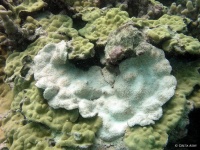How to identify coral bleaching: look for completely white coral colonies or white areas, then look closely for the bleached transparent polyps. For reporting purposes, note species, number of colonies affected and what percentage they are bleached.
Click on any photo to see slideshow with descriptions and full image capability
- Bleached red rice coral surrounded by healthy mounding corals
- Bleached mounding coral beside healthy mounding coral (Porites lobata)
- Partially bleached red rice coral (Montipora capitata)
- Bleached branching rice coral (Montipora capitata)
- bleached rice coral (Montipora capitata)
- Partially bleached mounding coral (Porites lobata)
- Bleached finger coral (Porites compressa)
- Close up of bleached finger coral (Porites compressa)
- bleached lobe coral (Porites evermanni)
- Partially bleached mounding coral (Porites lobata)
- Bleached mounding coral (Porites lobata)
- Partially bleached brown lobe coral (Porites evermanni)
- Close up of bleached coral polyps on brown lobe coral surrounded by healthy tissue
- Bleached areas on plate coral (Porites monticulosa) at 70 ft deep at Honaunau. Bleaching can also be caused by pollution and other stresses in addition to increased temperatures.
- Bleached areas on plate coral (Porites monticulosa) at 70 ft deep at Honaunau. Bleaching can also be caused by pollution and other stresses in addition to increased temperatures.
- Bleached red rice coral (Montipora capitata)
- bleached rice coral (Montipora capitata) **note that the rice coral sits between two blue rice coral (Montipora flabellata)
- Bleached blue rice coral (Montipora flabellata) on left and red rice coral (Montipora capitata) on right.
- Bleached Porites evermanni.
- Bleached Porites evermanni.
- Bleached tan/purple rice coral (Montipora patula). Notice purple rings around bleached polyps.
 Eyes of the Reef
Eyes of the Reef























